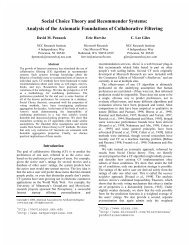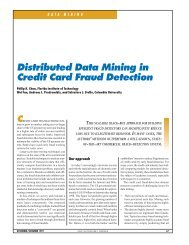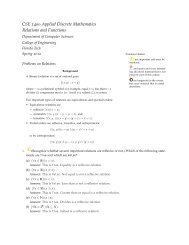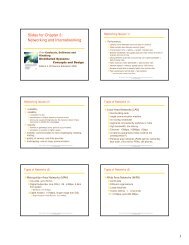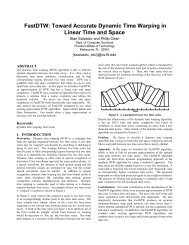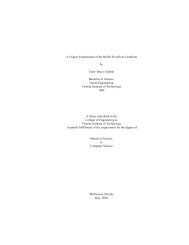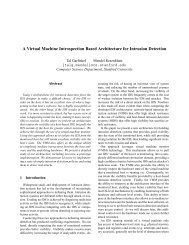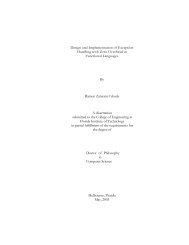Biclustering Algorithms for Biological Data Analysis
Biclustering Algorithms for Biological Data Analysis
Biclustering Algorithms for Biological Data Analysis
You also want an ePaper? Increase the reach of your titles
YUMPU automatically turns print PDFs into web optimized ePapers that Google loves.
<strong>Biclustering</strong> <strong>Algorithms</strong> <strong>for</strong><br />
<strong>Biological</strong> <strong>Data</strong> <strong>Analysis</strong><br />
Sara C. Madeira<br />
and Arlindo L. Oliveira<br />
Presentation by<br />
Matthew Hibbs
What is <strong>Biclustering</strong>?<br />
• Given an n x m matrix, A, find a set of<br />
submatrices, B k , such that the contents of<br />
each B k follow a desired pattern<br />
• Row/Column order need not be consistent<br />
between different B k s<br />
2
Why Bicluster?<br />
• Genes not regulated under all conditions<br />
• Genes regulated by multiple<br />
factors/processes concurrently<br />
• Key to determine function of genes<br />
• Key to determine classification of<br />
conditions<br />
3
Simple “Bicluster”<br />
Unclustered<br />
<strong>Data</strong>set from Garber et al.<br />
Clustered<br />
4
Formal Definitions<br />
• A contains rows X and columns Y<br />
• X = {x 1 , …, x n } Y = {y 1 , …, y n }<br />
• I ⊆ X, J ⊆ Y, A IJ = (I,J) = submatrix<br />
• I = {i 1 , …, i k } J = {j 1 , …, j s }<br />
5
Bipartite Graph<br />
• Matrix can be thought of as a Graph<br />
• Rows are one set of vertices L, Columns<br />
are another set R<br />
• Edges are weighted by the corresponding<br />
entries in the matrix<br />
• If all weights are binary, biclustering<br />
becomes biclique finding<br />
6
NP-complete<br />
Genes<br />
Conditions<br />
7
NP-complete<br />
Genes<br />
Conditions<br />
8
Ordering an Algorithm<br />
• Bicluster Type<br />
• Bicluster Structure<br />
• Algorithmic Approach<br />
9
Ordering an Algorithm<br />
• Bicluster Type<br />
• Bicluster Structure<br />
• Algorithmic Approach<br />
10
Bicluster Types<br />
• Constant values<br />
• Constant values on rows or columns<br />
• Coherent values<br />
• Coherent evolutions<br />
11
Constant Values<br />
Perfect: a ij = µ <strong>for</strong> all i ∈ I and j ∈ J<br />
Block Clustering, minimize variance:<br />
12
Constant Values on Rows/Cols<br />
Perfect constant Rows: Perfect constant Columns:<br />
13
Constant Values on Rows/Cols<br />
• Normalize rows/cols → constant value<br />
• Noise makes perfect biclusters rare<br />
– δ-valid ks-patterns (Califano et al.)<br />
14
Coherent values<br />
Perfect additive model: Perfect multiplicative model:<br />
15
Perfect δ-bicluster:<br />
Coherent values<br />
(Cheng & Church) Residue:<br />
Mean squared residue:<br />
16
Overlapping Coherent Values<br />
Plaid Model or General Additive Model (Lazzeroni and Owen)<br />
=<br />
17
Overlapping Coherent Values<br />
Gaussian Distribution with variance depending on<br />
row, column, and bicluster variance<br />
18
Coherent Evolutions<br />
• Order-Preserving Submatrix (OPSM, Ben-Dor et al.)<br />
• Order-Preserving Cluster (OP-Cluster, Liu and Wang)<br />
• Rank-based approaches<br />
19
Coherent Evolutions<br />
• Quantized expression levels into states<br />
• Maximize conserved rows/cols (Murali and Kasif)<br />
20
Coherent Evolutions<br />
• Identify “significant conditions” with respect to normal levels<br />
• Construct a bipartite graph containing only these edges<br />
• bicluster is biclique (simple SAMBA, Tanay et al.)<br />
21
Coherent Evolutions<br />
• Label “significant conditions” as up or down regulated<br />
• Select columns that have the same or opposite effect<br />
• (refined SAMBA, Tanay et al.)<br />
22
Ordering an Algorithm<br />
• Bicluster Type<br />
• Bicluster Structure<br />
• Algorithmic Approach<br />
23
Bicluster Structure<br />
Single Bicluster<br />
24
Bicluster Structure<br />
Exclusive row and column bicluster<br />
25
Bicluster Structure<br />
Non-overlapping checkerboard biclusters<br />
26
Bicluster Structure<br />
Exclusive-rows biclusters<br />
27
Bicluster Structure<br />
Exclusive-columns biclusters<br />
28
Bicluster Structure<br />
Non-overlapping tree structured biclusters<br />
29
Bicluster Structure<br />
Non-overlapping non-exclusive biclusters<br />
30
Bicluster Structure<br />
Overlapping hierarchically-structured biclusters<br />
31
Bicluster Structure<br />
Arbitrary overlapping biclusters<br />
32
Ordering an Algorithm<br />
• Bicluster Type<br />
• Bicluster Structure<br />
• Algorithmic Approach<br />
33
Algorithmic Approaches<br />
• Iterative row and column clustering combo<br />
• Divide and conquer<br />
• Greedy iterative search<br />
• Exhaustive bicluster enumeration<br />
• Distribution parameter identification<br />
34
Iterative Row and Column<br />
• Coupled Two-Way Clustering (CTWC)<br />
– Keep sets of row and column clusters<br />
– Start with all rows and all columns<br />
– Hierarchically cluster based on pairs of<br />
row/column clusters<br />
– Identify new “stable” row/column clusters<br />
– Repeat until a desired resolution<br />
35
Iterative Row and Column<br />
• Interrelated Two-Way Clustering (ITWC)<br />
– Cluster the rows into K groups<br />
– Cluster columns into two groups based on<br />
each row group<br />
– Combine row and column clusterings<br />
– Identify row/column cluster pairs that are very<br />
different from each other<br />
– Keep the best 1/3 rows in the heterogeneous<br />
pairs<br />
– Repeat<br />
36
Divide and Conquer<br />
• Block Clustering (Hartigan)<br />
– Sort by row or column mean<br />
– Find best row or column split to reduce “within<br />
block” variance<br />
– Continue, alternating row or column splits<br />
– Stop when arrive at desired K blocks<br />
• Very fast, but likely to miss good biclusters<br />
due to early splits<br />
37
Greedy Iterative Search<br />
• δ-biclusters (Cheung & Church)<br />
– Find biclusters with mean squared residue < δ<br />
– Iterative procedure<br />
• Remove the row/col that reduces H the most<br />
• Add rows/cols that do not increase H<br />
– Stop when H < δ<br />
– Mask bicluster with random values<br />
– Repeat to find next bicluster<br />
38
Exhaustive Bicluster Enumeration<br />
• Statistical-Algorithmic Method <strong>for</strong> Bicluster<br />
<strong>Analysis</strong> (SAMBA, Tanay et al.)<br />
– Conversion to bipartite graph<br />
– Equivalent to selection of heaviest subgraphs<br />
• Assumes rows have d-bounded degree<br />
– Report the K heaviest bicliques<br />
39
Distribution Parameter Identification<br />
• Plaid Model (Lazzeroni and Owen)<br />
– Given K-1 biclusters, select the Kth bicluster<br />
that minimizes sum of squared errors<br />
– Sort of like EM, determine θ from ρ and κ,<br />
then ρ from θ and κ, then κ from θ and ρ<br />
– “Fuzzy” membership until end (ρ, κ ∈ [0,1])<br />
40
Ordering an Algorithm<br />
• Bicluster Type<br />
• Bicluster Structure<br />
• Algorithmic Approach<br />
41
Comparison of <strong>Biclustering</strong> <strong>Algorithms</strong><br />
42
Other Applications<br />
• In<strong>for</strong>mation Retrieval<br />
– Targeted marketing<br />
– Text mining<br />
• Dimensionality Reduction<br />
– automatic subspace clustering<br />
• Electoral <strong>Data</strong> <strong>Analysis</strong><br />
• much more…<br />
43
Conclusions<br />
• <strong>Biclustering</strong> is useful <strong>for</strong> BioIn<strong>for</strong>matics<br />
and many other research areas<br />
• NP-Complete<br />
• Choice of bicluster type and structure with<br />
an algorithmic approach → Algorithm<br />
44



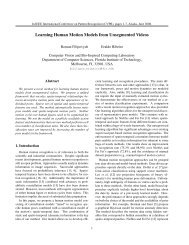
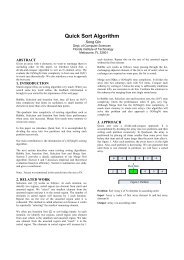
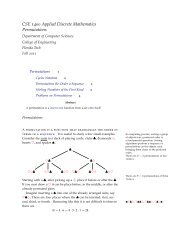
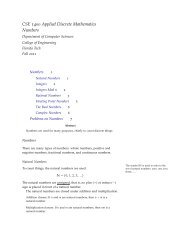
![{ public static void main (String[] args) { System.out.println (](https://img.yumpu.com/49719541/1/190x143/-public-static-void-main-string-args-systemoutprintln-hello-.jpg?quality=85)
